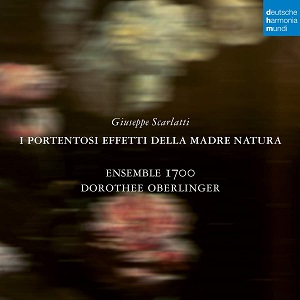
Giuseppe Scarlatti (1718–1777)
I portentosi effetti della Madre Natura, Dramma giocoso per musica (1752)
Celidoro, Rupert Charlesworth (tenor); Ruggiero, Filippo Mineccia (alto); Lisaura, Roberta Mameli (soprano); Cetronella, Benedetta Mazzucato (mezzo-soprano); Ruspolina, Maria Ladurner (soprano);
Poponcino, Niccolò Porcedda (baritone); Dorina, Dana Marbach (soprano); Calimone, João Fernandes (bass)
Ensemble 1700/Dorothee Oberlinger
rec. live, 12/14 June 2022, Schlosstheater Neues Palais, Potsdam Sanssouci
Italian libretto with English and German translation enclosed.
Reviewed as download from press preview.
Deutsche Harmonia Mundi 19658794542 [2 CDs: 155]
The Scarlatti family imprinted music history for several generations. Alessandro was a renewer of Italian opera around the turn of the 18th century, his younger brother Francesco wrote valuable sacred music and lived in London and later Dublin, Alessandro’s son Domenico, born the same year as Bach and Handel, possibly the most famous of the family, lived most of his life in Spain, and his 500 keyboard sonatas are regularly heard. Now pops up the nephew of Domenico, Giuseppe, who was a successful opera composer during the second half of the 18th century but after his death in 1777 his fame rapidly waned. He wrote his first opera in 1740 for Teatro Capranica in Rome, and then followed a steady stream of works, many of them to librettos by Metastasio. In 1752, he first met Carlo Goldoni in Venice, which resulted in I portentosi effetti della Madre Natura, premiered at San Samuele on 11 November in the presence of, among others, Giacomo Casanova, who liked it so much that he saw it again twelve years later at Charlottenburg Palace. As is well-known, Casanova also saw the premiere of Mozart’s Don Giovanni in Prague in 1787. I portentosi effetti della Madre Natura was performed in the Palace Theatre at Sanssouci in Potsdam in 1768, where it was seen again for the first time in modern times in 2022, when this live recording was made.
The story is typically complicated in the best comic opera tradition. The background is as follows (I quote from the synopsis): “Celidoro is the rightful ruler of the island of Mallorca but has been held captive since childhood and kept in total isolation. He knows only his jailer, Calimone, who takes care of him. He does not even know that he is a king. Celidoro manages to escape during a terrible storm and, as if reborn, he begins to discover the world for himself.” This leads him to a lot of events. He meets women for the first time in his life and immediately becomes lovesick, but he also manages to defeat Ruggiero, the usurper of the throne, and restore his royal power and then be able to marry Cetronella, the first woman he met, and everything is sorted out. In the final chorus the whole ensemble ”celebrate the wondrous workings of the Great Mother [of Nature], who has arranged everything for the best.”
Goldoni’s libretto is really entertaining and witty; even though it is a long work it seldom outstays its welcome. The structure is the usual for its period: a chain of musical numbers – mainly arias – tied by secco recitatives accompanied by forte piano. Unlike the Baroque tradition from grandpa Alessandro and Handel, however, only a few arias are da capo. Stylistically, we are in the realm of Haydn and Mozart with more flexible arias and also a limited number of ensembles: a couple of duets, a terzetto and the third act is rounded off with a long quartetto. Besides the pompous overture there are several instrumental interludes, some of them from orchestral works by the composer, others from works by Pergolesi et al – rearranged by Dorothee Oberlinger. The sum of all this is an attractive mix of melodious and dramatic music. Several of the numbers are worth hearing, isolated from the plot just for the sake of the beauty of the music. Cetronella’s first aria (CD 1 track 6), gentle and inward, is one to savour, and Celidoro’s Donna, vi lascio il cor (CD 1 track 10) is another. A little later in the first act Lisaura has a long dramatic coloratura aria, which is one of the high spots in this opera. Otherwise, most of the arias are fairly short. At the beginning of Act II, Dorina has a very beautiful solo with harp accompaniment (CD 2 track 2), even though the singing isn’t so distinguished. Just a minute later, Ruggiero, the bad guy in this work, sings Sarai felice with flute accompaniment (CD 2 track 4). This is one of the few da capo arias, and he has another one in the last act, fast, dramatic and intense (CD 2 track 24). The singer here, Filippo Mineccia, was the only singer in the cast I can remember hearing before. Some six years ago I reviewed a recital disc where he sings arias by Niccolò Jommelli, roughly a contemporary of Scarlatti (review). The good impression he made then is reinforced here. In that act a highlight is also Cetronella and Celidoro’s concluding love duet.
The solo singing is generally on a high level with Rupert Charlesworth’s nuanced, expressive and brilliant Celidoro and Benedetta Mazzucato’s many-faceted Cetronella as frontrunners. Roberta Mameli’s brilliant coloratura and dramatic intensity as Lisaura and Filippo Mineccia’s Ruggiero should also be mentioned, but there are no really weak links here. Ensemble 1700 under Dorothee Oberlinger deliver idiomatic playing and contribute to a surprising find of a totally forgotten opera that every lover of 18th century opera should hasten to hear. The recording is excellent, and there are practically no audible signs of an audience present – until at the very end when the enthusiastic ovations are almost deafening.
Göran Forsling
Help us financially by purchasing from




















